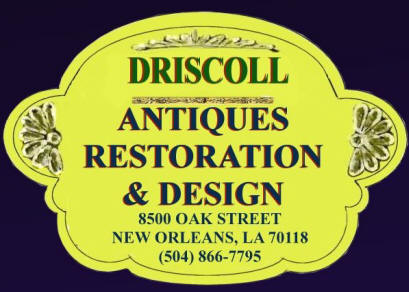| Driscoll Antiques restores furniture using the traditional techniques
practiced during the 18th and 19th centuries. Where ever possible we use
the same type of materials that were originally used on the piece that
we are working on. Our finish on woods like mahogany and walnut is shellac.
We make our shellac fresh using crystal flakes and alcohol shortly before
the application. It is important that the shellac is fresh because it has
a shelf life of six months. If we suspect that the customer is going to
use a piece of furniture on a daily basis we protect it with a top coat
of nitrous cellulose lacquer. This type of finish gives the look of the
old traditional finishes with the protection for daily use. Repairing damage
to a nitrous cellulose lacquer finish is easier and most times more successful
than on other factory type finishes. A shellac and lacquer finish ages
very well. It actually looks better as it ages if properly applied and
maintained. On hard woods like maple, oak and teak wood we prefer the English
tradition of oiling the wood to preserve it then protecting the surface
with wax.
The last step in all of our finishes is the application
of wax containing Carnauba. We do not use bees' wax because it draws in
moisture from the air and each droplet contains a small particle of dirt.
Over time this gives your finish a dark dull look and most of the character
of the grain is obscured. Many of our customers don't realize that an antique
does not have to look this way. Carnuba by it's self is not easily applied
to the wood but when it is mixed into a wax it penetrates the surface and
invades each wood cell where it becomes hard and makes the surface water
resistant for quite some time.
Maintaining An Antique finish
Maintaining a professionally applied antique finish
is important to its graceful aging. We do not recommend the use of furniture
treatments found in a hardware or grocery store. If you have the opportunity
to visit our showroom you will undoubtedly notice the depth and sheen of
our finishes on highly polished pieces and the presence and clarity of
the wood grain on our rubbed and oiled finishes. You will not see a hazy
film of wax or oil residue that most antique over the counter treatments leave. The only thing that we use in our showroom
to maintain our finish after waxing is a feather duster. When the dust
is not easily whisked away, it is time to rewax. Contaminates in the air
corrode the finish on furniture. The cleaner the air in your surroundings
and the more dust free your furniture is, the longer the time before waxing.
At Driscoll Antiques we routinely apply numerous coats of wax to a piece
of furniture before it leaves our shop. To maintain the look and protection
level of our finish it is only necessary to reapply 1 coat of a carnauba
wax when you feel that the feather duster is not doing a satisfactory job.
Carnauba wax is a beneath the surface protection so it is important to remove
the excess left on the surface as it is drying. Lint free cheese cloth
is best for polishing the surface to a deep luster after the wax has thoroughly
dried.
Driscoll's Home
Page
email: driscoll@driscollantiques.com
|

